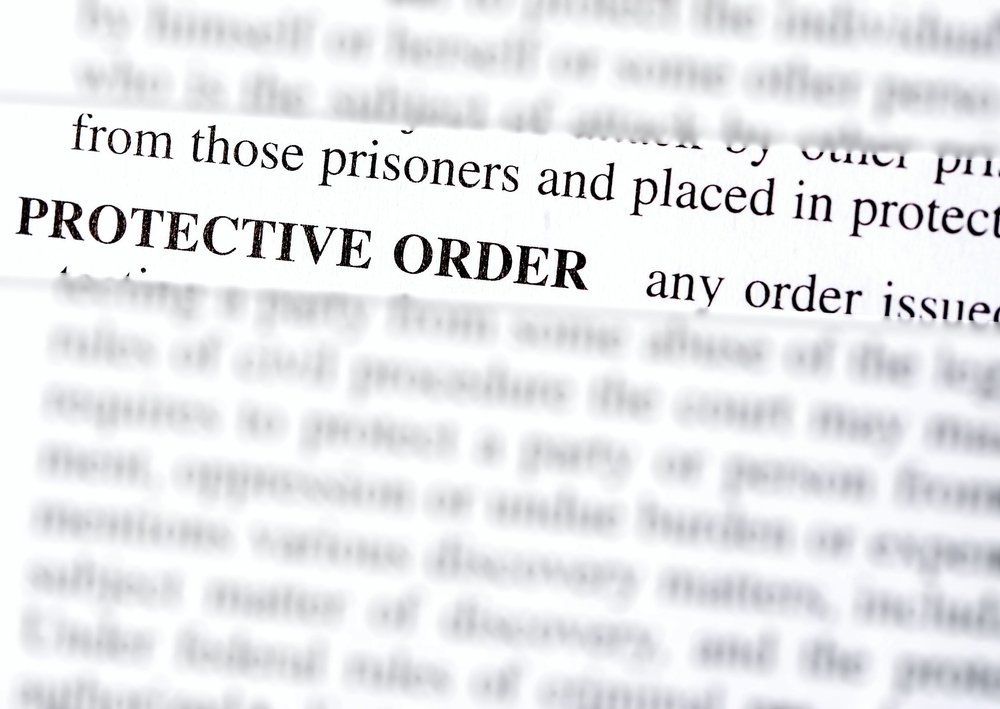
A restraining order is a powerful legal tool designed to prevent further harassment, threats, or harm. Understanding your next steps—whether you’ve been advised by police to obtain one or if you've been served—is critical to protecting your rights and ensuring your safety.
In this guide, we provide helpful insight into the steps you should take, including how an experienced criminal defense attorney can assist you, whether you’re seeking one or defending against one.
Types of Restraining Orders in Los Angeles, California
In California, the most common types of protective orders include:
Domestic Violence Restraining Orders (DVROs)
- Apply when the person causing harm is a spouse, ex-spouse, dating partner, parent of your child, close family member, or someone you live or lived with.
- These orders protect against physical abuse, threats, stalking, harassment, and emotional abuse. Courts can order the person to move out of your home, stay away from your workplace or school, and stop all forms of contact.
Civil Harassment Restraining Orders
- Used when the person harassing you is not closely related—such as a neighbor, roommate, friend, landlord, or stranger.
- These orders apply in cases of stalking, threats, unwanted contact, or harassment that doesn’t involve domestic or familial relationships. It can restrict personal, digital, or third-party contact.
Workplace Violence Restraining Orders
- Requested by an employer on behalf of an employee who has experienced violence or credible threats in the workplace.
- These orders protect employees from individuals who have stalked, threatened, or assaulted them at work, and can prevent the aggressor from entering the job site or contacting the employee.
Elder or Dependent Adult Abuse Restraining Orders
- Designed for individuals 65 or older, or adults between 18–64 with certain disabilities, who are experiencing physical abuse, neglect, financial exploitation, or emotional abuse.
- These orders help protect vulnerable adults from caregivers, family members, or others who are abusing or manipulating them.
Each applies based on the relationship and threat level.
Steps to Take if You Are Seeking a Restraining Order in California
1. Take the Recommendation Seriously and Get Support
If the police advise you to get a restraining order, take the suggestion seriously. If they are suggesting it, it’s because they believe it’s necessary for your safety.
Of course, doing so can feel intimidating, especially if you don’t know where to start. If you are unsure of where to turn, you can ask law enforcement or local domestic violence advocacy groups for guidance. These organizations can even help you fill out the correct forms to get the process started.
There’s another angle to consider, as well: emotional support. We understand that this is an uncomfortable and frightening thing to do, so identify your support system, whether it be a friend, relative, or co-worker.
2. Document the Incidents
Did an altercation with your spouse result in bruising? Is your neighbor sending you threatening messages on Facebook over a property line dispute? Did your co-worker harass you? In every instance of abuse, whether physical or emotional, be sure to document what happened.
Make sure your documentation includes who was involved, as well as when and where it happened.
3. Gather Evidence
In most cases, you won’t need to present a lot of evidence to obtain a temporary restraining order (TRO) in California. However, you will need it if you want to keep the temporary order permanent. As such, gather as much evidence as you can to present to the court. Things like voicemails, emails, text messages, DMs, and letters can all prove invaluable in your pursuit of a restraining order.
Remember, it’s better to err on the side of caution and have more than you think you need. Don’t hesitate to screenshot conversations, photos, social media messages, timestamps, and anything else you think could serve as a critical piece of evidence. If available, include incident logs, police reports, medical records, and photos that support claims of property damage or injury.
4. Fill Out the Paperwork and Understand What Relief to Request
When pursuing a restraining order in Los Angeles, you may be asked to complete paperwork such as:
- Form DV-100 (Request for Domestic Violence Restraining Order): This is the main form used if you're seeking protection from someone you’ve had a close relationship with—like a spouse, ex, partner, or close family member. It asks you to explain what happened, what kind of protection you're requesting, and whether children are involved.
- Form CH-100 (Request for Civil Harassment Restraining Order): If the person bothering you is not a close family member or partner—such as a neighbor, coworker, or acquaintance—this is the form you’ll likely use. You’ll need to detail the harassment and provide any supporting facts or documentation.
- Form WV-100 (Request for Workplace Violence Restraining Order): If you need protection from an employee at work who has stalked or created a reasonable fear of violence, this is the form you will use.
- Form EA-100 (Request for Elder or Dependent Adult Restraining Order): For vulnerable adults that need protection, either they or their caregivers can fill out this form, which starts the process of getting a restraining order.
In addition to correctly completing these forms, it's essential to understand precisely what relief to request. The types of relief available may include:
- Personal Conduct Orders: Prohibit the restrained person from contacting, threatening, or harassing you.
- Move-Out Orders: Require the restrained individual to move out of a shared residence.
- Child Custody/Visitation Orders: Establish temporary custody or visitation arrangements to protect children involved.
- Firearm Surrender Requests: Mandate the restrained person to surrender any firearms they possess.
If you are considering hiring an attorney, let us determine the type of restraining order you need and the relief to request. What’s included in the filing can have a tremendous impact on the outcome of your case. Before submitting the forms, your attorney will make at least two copies. Then, they’ll file the paperwork at your local courthouse and may also request a temporary restraining order that remains in effect until your hearing date.
5. Clearly State the Facts in Your Petition
When you're filing a restraining order, emotions can run high, making it tempting to include personal opinions or criticisms. Instead, focus strictly on the facts of your situation. Clear, factual statements help your petition move efficiently through the court process. They also strengthen your credibility when your lawyer represents you before a judge. Avoid accusations or inflammatory language, and simply describe what occurred.
Common Reasons People Seek Restraining Orders
Many people seek restraining orders due to:
- Physical violence or threats of harm
- Stalking or persistent unwanted contact
- Harassment in person or online
- Property damage and intimidation
- Emotional abuse that causes lasting fear
Even if no physical assault occurred, repeated fear-based behaviors may justify protection under the law.
Renewing or Modifying Your Restraining Order
Most restraining orders expire after a set time—often a few months to five years. You can request a renewal before it ends if you still feel threatened.
Modifications may also be available if circumstances change. For example, if the person moves away or contacts you inappropriately, you can ask the court to adjust the terms.
Steps to Take if You Are Served with a Restraining Order in California
Receiving a restraining order can be unsettling, but taking these steps can protect your legal interests:
1. Read the Restraining Order Carefully
Fully understand the restrictions placed upon you, including upcoming court dates, changes to child custody, move-out orders and if you have to surrender your firearm. Ignorance of the conditions listed in the restraining order will not be accepted as an excuse and violating them could land you in hot water.
2. Comply Immediately
Even if you disagree with the allegations, you must comply with the restraining order. As mentioned above, violating the terms could get you in serious trouble and further complicate the situation you’re in.
In many cases, those found to be in violation of a restraining order could be facing up to one year in a county jail and a fine up to $1,000. A restraining order defense attorney in Los Angeles can advocate for you in court. However, following the terms outlined until the court hearing is imperative.
3. Do Not Contact the Other Party
You may feel tempted to contact the person who served you with the restraining order to work the whole thing out. However, this is the last thing you should do. Once the restraining order is in place, you cannot legally contact the other party, as it would violate the terms outlined in the order.
Don’t have someone you know, even if they’re a neutral party, reach out to the person who filed the restraining order either. Some people believe this is a work around, but it is still considered a violation and can lead to the penalties above. Let your defense lawyer do the talking for you in court, and leave personal conversation out of it.
4. Collect Evidence and Witnesses and Start Drafting a Timeline
Just like the petitioner needs to gather evidence, so do you if you’re being served with a restraining order. Collect evidence that counters the allegations against you, including text messages, social media messages, emails, and voicemails. If there are witnesses who can dispute the petitioner’s claims or speak on your character, be sure to collect their contact information so your lawyer can speak with them.
Likewise, start drafting a timeline of events, including when you noticed a change in behavior, what happened leading up to the filing, and when the restraining order was filed.
Unfortunately, not every restraining order is filed in good faith, so if you have evidence that supports your innocence, collect and share it with your attorney. A timeline of events can paint a picture that proves the restraining order was retaliatory.
5. Hire a Criminal Defense Lawyer
Though you may be tempted to deal with the restraining order yourself, doing so without legal representation is risky. Once you’re served, consult with an experienced criminal defense attorney.
Your attorney will be able to help you understand the terms of the restraining order, your rights, and advocate for you in court.
A restraining order can put a serious strain on your life and freedom. There’s simply too much at stake to navigate these uncharted waters without experienced legal guidance.
6. Attend the Court Hearing
After being served with a restraining order, you have the right to present your side of the story to a judge. At your court hearing, be sure to arrive on time, dress respectfully, and adhere to courthouse rules including turning your phone on silent, referring to the judge as “Your Honor,” and not bringing in food or drinks.
Your attorney will be able to provide evidence to the judge, respond to allegations and serve as your voice throughout the proceedings, shielding you from pressure, manipulation and aggressive tactics.
Similar Post: Emergency Protective Orders in California: What to Do If You’ve Been Served
Were You Served with a Restraining Order or Seeking to Get One in Los Angeles? The Law Offices of Christopher Chaney Can Help
Our firm has years of experience representing Los Angeles residents who either want to file a restraining order or have recently been served with one. We understand the complex emotions that go along with obtaining and responding to restraining orders. We’re here to answer your questions and explain your rights.
Give our law firm a call today at 818-330-5198 or fill out our online contact form to speak with one of our experienced attorneys. We represent clients throughout California, including Los Angeles County, Orange County, and Ventura County.
Disclaimer: This blog is intended for informational purposes only and does not establish an attorney-client relationship. It should not be considered as legal advice. For personalized legal assistance, please consult our team directly.





